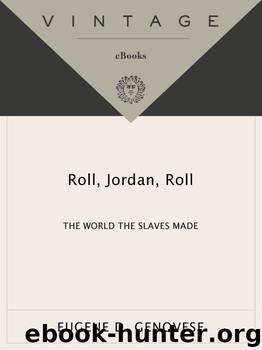Roll, Jordan, Roll: The World the Slaves Made by Eugene D. Genovese

Author:Eugene D. Genovese [Genovese, Eugene D.]
Language: eng
Format: mobi
Publisher: Knopf Doubleday Publishing Group
Published: 2011-02-09T08:00:00+00:00
But if most of those emancipated originated in miscegenation, most issue from miscegenation did not gain their freedom. Olmsted’s reports from Virginia applied to the whole South: a large majority of mulatto children born to slaveholders lived their lives as slaves, often with no special consideration or privileges.13
Some light on the quality of the more tangled relations comes from an unlikely source. For the pleasure of the wealthiest planters, or more likely their unmarried sons, New Orleans, Louisville, and a few other cities maintained “fancy-girl” markets, which aroused the special ire of the northern abolitionists. These girls, young, shapely, and usually light in color, went as house servants with special services required. First-class blacksmiths were being sold for $2,500 and prime field hands for about $1,800, but a particularly beautiful girl or young woman might bring $5,000. Wherever slavery has existed such markets have existed also. “With this, as with any other merchandise,” writes Iris Origo about the market for Eastern European fancy girls in Renaissance Tuscany, “peculiarly attractive wares could command what the Italian phrase aptly calls a prezzo d’affezione.”14
These sales, private and public, went on in full view, drew attention but not much censure from the southern press, and were considered by the slaveholder’s society more of a curiosity of upper-class life than a moral problem. Northern antislavery writers expressed outrage on two counts: concern for the young women forced into degrading relationships with debauched white men; and special concern about the young women’s so often being virtually white. A touch of racism may have paid political dividends, for northern opinion responded so much more readily to the exploitation of quadroons and octoroons than it ever would have if the preference of the southern gentlemen had been for blacks. The fate of these young women varied greatly. Some of their purchasers undoubtedly were the most dissolute members of the planter class, although their having been so did not necessarily mean that they treated their concubines worse than did the less tainted souls. The women left no record of their attitudes. Some may have resembled Maria, whom Solomon Northup described:
Maria was a rather genteel looking colored girl, with a faultless form, but ignorant and extremely vain. The idea of going to New-Orleans was pleasing to her. She entertained an extravagantly high opinion of her own attractions. Assuming a haughty mien, she declared to her companions, that immediately on our arrival in New-Orleans, she had no doubt some wealthy single gentleman of good taste would purchase her at once!15
Download
This site does not store any files on its server. We only index and link to content provided by other sites. Please contact the content providers to delete copyright contents if any and email us, we'll remove relevant links or contents immediately.
| Anthropology | Archaeology |
| Philosophy | Politics & Government |
| Social Sciences | Sociology |
| Women's Studies |
Cecilia; Or, Memoirs of an Heiress — Volume 1 by Fanny Burney(32385)
Cecilia; Or, Memoirs of an Heiress — Volume 3 by Fanny Burney(31760)
Cecilia; Or, Memoirs of an Heiress — Volume 2 by Fanny Burney(31729)
The Great Music City by Andrea Baker(31211)
We're Going to Need More Wine by Gabrielle Union(18914)
All the Missing Girls by Megan Miranda(15423)
Pimp by Iceberg Slim(14237)
Bombshells: Glamour Girls of a Lifetime by Sullivan Steve(13933)
Talking to Strangers by Malcolm Gladwell(13144)
Norse Mythology by Gaiman Neil(13143)
Fifty Shades Freed by E L James(13129)
For the Love of Europe by Rick Steves(12397)
Crazy Rich Asians by Kevin Kwan(9136)
Mindhunter: Inside the FBI's Elite Serial Crime Unit by John E. Douglas & Mark Olshaker(9115)
The Lost Art of Listening by Michael P. Nichols(7366)
Enlightenment Now: The Case for Reason, Science, Humanism, and Progress by Steven Pinker(7094)
The Four Agreements by Don Miguel Ruiz(6552)
Bad Blood by John Carreyrou(6483)
Weapons of Math Destruction by Cathy O'Neil(6090)
